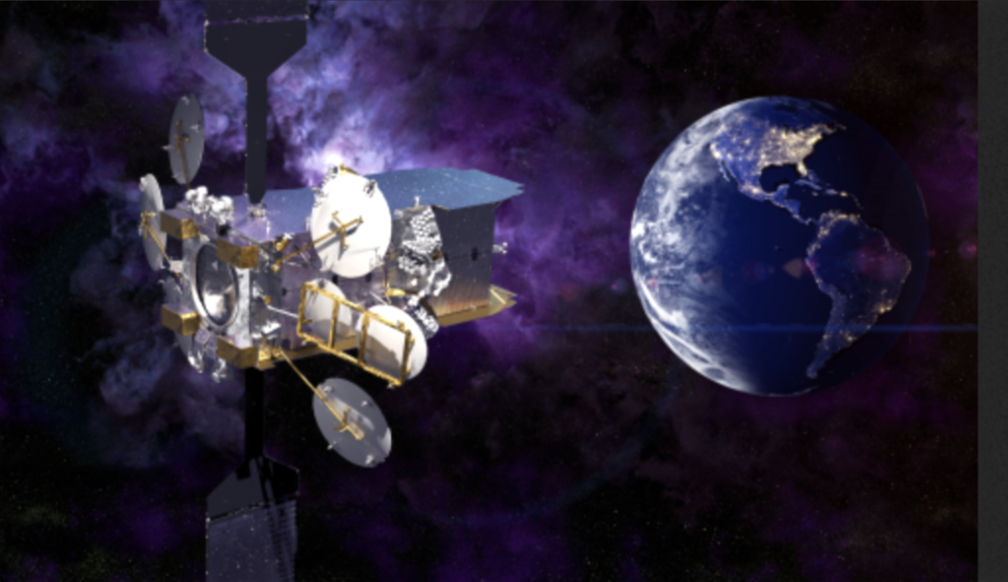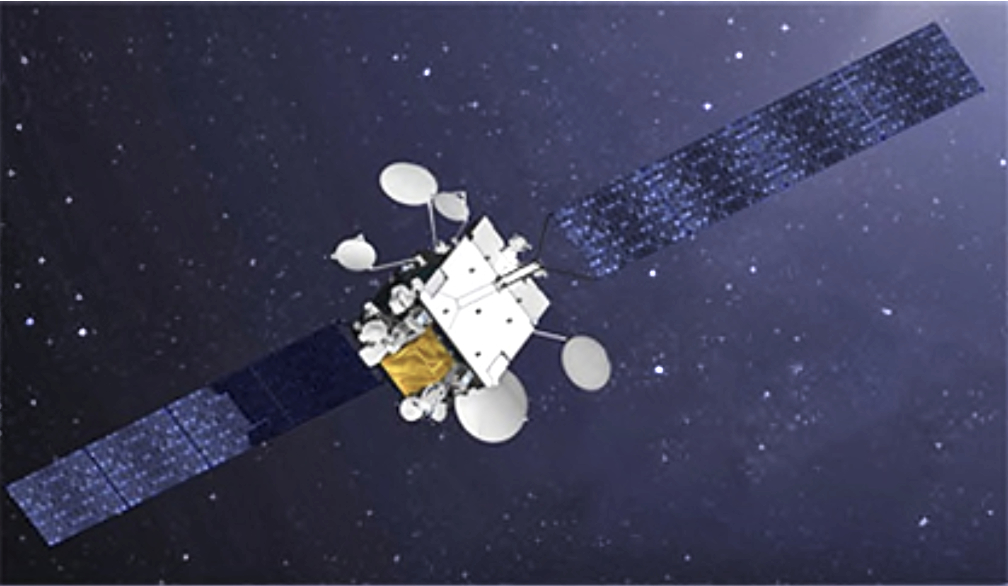
On Sunday, October 24, at 02:10 UTC, Ariane 5 lifted off from the Guiana Space Center (CSG) and successfully orbited two satellites built by Thales Alenia Space, those being SES-17, a telecommunications satellite operated by SES, and SYRACUSE 4A, a telecommunications satellite developed for the French Ministry of the Armed Forces.


With this 111th mission, Ariane 5 broke the record for the cumulative net mass ever delivered to Geostationary Transfer Orbit (GTO) by a single launcher. With a total performance of 11.2 metric tons, the mass of the Ariane 5’s payloads reached 10,264 kg at separation (6,411 kg for SES-17 and 3,853 kg for SYRACUSE 4A). For this mission, Ariane 5 also reached a height of 56.4 meters, thanks to a 1.5 meter extension placed under the long fairing.
This launch sent two satellites into orbit:
- SES-17
This High Throughput telecommunication satellite (HTS) provides excellent coverage over the Americas, the Caribbean and the Atlantic Ocean and has been designed to transform the aviation connectivity landscape, address data demands across maritime, government and enterprise segments, as well as to accelerate digital inclusion initiatives. It features almost 200 spot beams, the power of which can be dynamically adjusted in step with customers’ changing requirements. It is also the first SES satellite to have a totally digital payload, powered by an advanced digital transparent processor (DTP), enabling far greater flexibility and efficiency than previously available. The satellite will form a multi-orbit network adaptable to varying bandwidth and latency requirements, operating with SES’ next generation non-geosynchronous satellite system, O3b mPOWER.
The Thales Alenia Space’s 5th generation Digital Transparent Processor (DTP) embarked on SES-17 allows for easy frequency conversions as well as unlimited gateway switching and traffic routing. Combined to flexible amplifiers, it will meet customer’s changing requirements and real time traffic demands.
SES-17 marks an important milestone in satellite technology as the first Ka-band geostationary satellite to embark a fully digital payload powered the most powerful digital transparent processor (DTP) ever placed in orbit. It will have nearly 200 user beams that can be connected to any other beam at any time. This, combined with the ability to dynamically change the power and frequency allocation of any beam, means that SES-17 can adapt to changing customer needs in real-time.
This also the first GEO satellite to use Adaptive Resource Control (ARC), an industry-first software system that leverages the full flexibility of totally digital payloads to autonomously adapt space and ground resources on the fly to meet customer needs.
Equipped with an all-electric propulsion system, the satellite will reach orbit as of mid-2022. When operational, anchor customer Thales InFlyt Experience will use SES-17’s connectivity to power its next-generation aviation connectivity solution, FlytLIVE. Thales InFlyt Experience will ensure both crew and passengers will have an always-on high-speed Wi-Fi connection at peak times and in high-traffic routes while optimizing bandwidth.
- SYRACUSE 4A
This military communications satellite, commissioned by the Armament General Directorate DGA, will allow to connect the armed forces together when deployed. At sea, in the air or on the ground, militaries need secured and powerful communication means in order to be able to exchange information with the command center. Thanks to its state-of-the-art equipment (anti-jamming antenna and digital transparent processor on board), SYRACUSE 4A will guarantee a high resistance to extreme jamming methods. At the service of France’s sovereignty, the satellite will also support NATO and European-led operations.
Developed under the leadership of the DGA in close coordination with the national center for space studies (CNES), the Space Command of the French Air and Space Force and the other armed forces, SYRACUSE 4A was built by Thales Alenia Space. In the upcoming years, two other military telecommunications satellites will join it in order to create a constellation that will serve the needs of the Armed forces in an ever-growing digitalization of the battlefield. SYRACUSE 4A will connect most naval vessels, moving armored vehicles or aircraft: in particular Griffon armored vehicles, upcoming Suffren attack submarines or the tanker Phoenix.
The Syracuse IV defense communications satellite segment, comprising three satellites, of which the first 2, Syracuse 4A and Syracuse 4B, are built for the French defense procurement agency DGA (Direction Générale de l’Armement) by the industrial consortium formed by Thales Alenia Space and Airbus Defence and Space. Thales Alenia Space is in charge of the Syracuse 4A satellite and co responsible with Airbus Defence and Space of the payloads for both satellites. Initiating the replacement of the previous generation, Syracuse 4A is designed to be compatible with the existing system, while also delivering expanded capacity and new functions for armed forces, especially greater throughput, capacity and flexibility, along with a broader coverage zone. Because of this flexibility, the satellite can meet the needs of forces deployed anywhere in the coverage zone, while also efficiently managing its X-band and Ka-band resources. Unlike commercial satellites, the Syracuse satellites have to resist a wide variety of potential threats, including jamming, to guarantee service continuity and resilience. Built on the all-electric Spacebus NEO platform, Syracuse 4A features the latest cyber-defense and data encryption technologies – two areas in which Thales is a leader for both terrestrial and space applications.
For Syracuse IV, Telespazio, Joint Venture between Leonardo (67 %) and Thales (33 %), is in charge of the orbital positioning and station keeping for the satellites and will support the Ministry of the Armed Forces by contributing to its valorization and exploitation during the next 15 years. Thales is supplying the ground segment, which will rely on its highly, protected, secure and high-performance Modem 21 transmission system, as well as hardened tactical and naval ground stations, to guarantee the availability and confidentiality of all communications and provide protection from the full spectrum of threats. SYRACUSE is the French military satellite communications (MILSATCOM) program that kicked off in 1980. It handles all military communications between headquarters in France and units deployed in different theaters of operation. The program is designed to provide an independent solution to meet France’s need for long-range, secure telecommunications, protected against electronic warfare. Three generations of Syracuse satellites built by Thales Alenia Space were deployed between 1984 and 2015.
SES-17 and SYRACUSE 4A will be the 164th and 165th Thales Alenia Space satellites to be launched by Arianespace.
“With this new success for Ariane 5, which comes a week after its previous launch, Arianespace is delighted to serve the interests of two loyal customers, the operator SES and the French Ministry of the Armed Forces”, said Stéphane Israël, Chief Executive Officer of Arianespace. “VA255, by putting two highly innovative satellites manufactured by Thales Alenia Space into orbit, demonstrates once again the competitiveness and reliability of our launch solutions serving the ambitions of our private and institutional clients. Dedicated to connectivity and security, these satellites are at the core of our mission: Space for a better life on Earth. The next challenge for Ariane 5 will be the launch of NASA's space telescope, James Webb, in partnership with the European Space Agency. Mission to Success!”
"With all the European industrial partners of the Ariane 5 program, we are proud to have set a new world record for performance to geostationary transfer orbit, serving two major and long-standing Arianespace customers. We continue to improve the European heavy launcher, and there are now six Ariane 5 launches left before it definitely enters the legend as the most reliable launcher in the world, much to the benefit of Ariane 6 that will take over flight duties in 2022. ArianeGroup is determined to innovate more and more to provide Europe with an ever more reliable access to Space,” said André-Hubert Roussel, CEO of ArianeGroup. “This launch of SES-17 is an exciting milestone for our FlytLIVE Connectivity Solution currently flying within the United States,” said Craig Olson, Vice President at Thales InFlyt Experience. “The network and satellite architecture was specifically developed for the unique connectivity requirements of our commercial aviation customers and their passengers. With SES-17, FlytLIVE will provide full coverage for the entire Americas and North Atlantic Corridor delivering an unmatched connectivity experience in the air.” “We are immensely excited to have SES-17 join our GEO fleet and medium earth orbit (MEO) constellation. SES-17 is the fruit of a successful collaboration between the Thales Group, Thales Alenia Space and SES, and will enable us to address the exponential connectivity demands in aviation and maritime, and to accelerate digital inclusion initiatives across the Americas,” said Steve Collar, CEO of SES. “Thanks to Arianespace, SES-17 is now on its way to orbit. We are looking forward to SES customers being able to leverage the high throughput, global reach and low-latency of SES’s multi-orbit, interoperable Ka-band satellite network comprising SES-17 and our upcoming O3b mPOWER constellation.” “What a launch – SES-17 has mobilized all Thales Alenia Space experts – from the innovative design of the satellite itself to the last combined operations – and is now on its way to orbit. Fully-digital and highly-innovative, SES-17 will benefit from all the state-of-art technologies we have developed to fulfil the market’s connectivity needs,” said Herve Derrey CEO of Thales Alenia Space.
ArianeGroup is the prime contractor in charge of the development and production of the Ariane 5 and Ariane 6 launchers. It leads an industrial network comprising more than 600 companies, including 350 small and medium-size enterprises (SME). ArianeGroup oversees the entire Ariane 5 industrial supply chain, from design studies and upgrades to production and mission-specific data and software. The supply chain encompasses equipment and structures, manufacture of the propulsion systems, stage integration, then integration of the launcher in French Guiana. ArianeGroup delivers a flight-ready vehicle on the launch pad to its subsidiary Arianespace, which operates the flight starting with liftoff on behalf of its customers.
SES’ vision is to deliver amazing experiences everywhere on Earth by distributing the highest quality video content and providing seamless connectivity around the world. As the leader in global content connectivity solutions, SES operates the world’s only multi-orbit constellation of satellites with the combination of global coverage and high performance, including the commercially-proven, low-latency Medium Earth Orbit O3b system. By leveraging a vast and intelligent, cloud-enabled network, SES is able to deliver high-quality connectivity solutions anywhere on land, at sea or in the air, and is a trusted partner to the world’s leading telecommunications companies, mobile network operators, governments, connectivity and cloud service providers, broadcasters, video platform operators and content owners. SES’s video network carries more than 8,650 channels and has an unparalleled reach of 361 million households, delivering managed media services for both linear and non-linear content. The company is listed on Paris and Luxembourg stock exchanges (Ticker: SESG).
